Fernan Federici
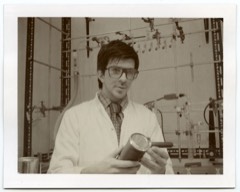
Research
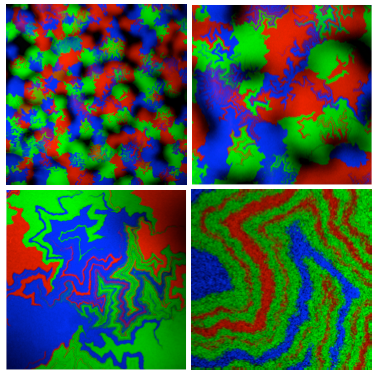
The programmable rhizosphere
This project aims to engineer a reliable platform for implementing artificial mutualism between a plant (Arabidopsis thaliana) and soil microbes (Bacillus subtilis; Escherichia coli). Natural symbiotic interactions between plants and microbes are being already exploited in agriculture. However, reprogramming these natural relationships to perform novel tasks or transferring them to other species has proven to be very difficult. Synthetic Biology offers a more reliable, scalable and transferable approach by the development of artificial genetic circuits for controllable interactions. We are currently working on the development of synthetic bidirectional signalling mechanisms between plants and soil microbes based on homoserine lactones (HSL) and short peptides. Establishing modular bidirectional communication mechanisms would provide a basis for self-contained micro-environments that provide protection and the appropriate conditions for metabolites interchange, nutrients uptake and plant growth-promoting mechanisms.

Physical self-organization in biofilms
We have used high resolution confocal microscopy and bacterial cell lineage marking tools to observe self-similar fractal-like morphology in biofilms. We have used fast, large-scale biophysical and genetic modelling tools developed by Tim Rudge and PJ Steiner to simulate biofilms and population boundaries. We have used these computational tools to reveal emergent properties of cell-shape that give rise to these patterns.
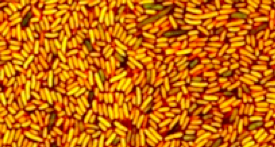
Ratiometric characterization of biological parts in microbes.
The design and construction of robust and predictable genetic circuits relies on the functional properties of Biobricks. Microbial ratiometric characterization is a novel technique for Biobricks characterization in bacteria that combines the use of an internal genetic reference for normalization and a new set of computational tools for its analysis. This work has been done in collaboration with Dr James Brown during his PhD project.
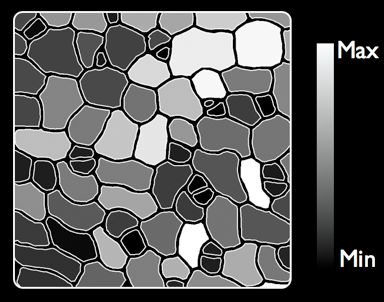
In planta cytometry
Studies of plant organogenesis and the design of artificial circuits for reprogramming this process rely on computer-aided data analysis and mathematical modelling. These models require information regarding cell growth and gene expression mapped onto the topology of cell arrangements within the organ. New tools for cell-based measurements of gene activity and tissue strain rate are therefore required for derivation of the elementary logic that drives plant morphogenesis. We have coupled the use of specifically localized fluorescent gene markers and image processing techniques for automated quantitative analysis of cell growth and genetic activity across living plant tissues. We used fluorescent protein markers to identify cells, create seeds and boundaries for the automatic segmentation of cell geometries and a novel technique for ratiometric measurement of gene expression. This technique is being applied to characterize biological parts in plants and superimpose this information to biophysical models developed by Tim Rudge and Lionel Dupuy. Although these techniques have been tested in plants; they could be potentially applied to other organisms.

Neo-morphogenesis in plants
Due to the presence of the cell wall, plant cell positions remain fixed after division stopping them from sliding with respect to each other. Plant architecture is therefore regulated by the rate and orientation of cell division and expansion within tissues. Local regulation of these processes within domains of cells and the mechanical coupling across the tissue give rise to the emergence of the diverse structures found in plants. A hierarchical establishment and maintenance of these cellular domains plays a key role in the regulation of plant morphogenesis. We have taken a synthetic biology approach to reprogram morphogenesis in plants by using modular genetic circuits that i) establish artificial cellular domains through cell-cell signalling, ii) maintain the boundaries between domains to preserve the transcriptional state of cells, iii) regulate cell division and expansion within the limits of these domains, and vi) hook these modules in a hierarchical fashion. I am currently working on the development and characterization of new genetic tools for plant synthetic biology; such as cell autonomous transcriptional repressors, non-cell autonomous activators and repressors; and laser-induced clonal sector gene activation. These tools would allow us to build more predictable genetic circuits. The design process is assisted by computational tools developed by Tim Rudge, Lionel Dupuy and PJ Steiner that include a formal description of the physical properties of cells and the performance of the genetic components.
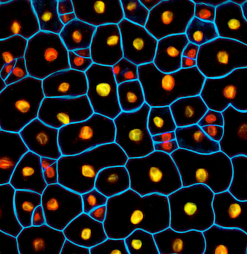
Synthetic development: Genetic circuits for artificial segmentation
This is a project in collaboration with Tim Rudge that aims to program bacterial biofilms to differentiate into domains. Using principles from developmental biology, we are designing bacterial transcription networks that will divide a biofilm into segments of distinct gene expression in response to a gradient of an external signal. We are combining ratiometric characterization of the used genetic components with high-throughput computational modeling from Tim Rudge to evaluate attainable regions of network space. This work has highlighted natural motifs, and novel circuits that will be useful in engineering complex multicellular behavior.
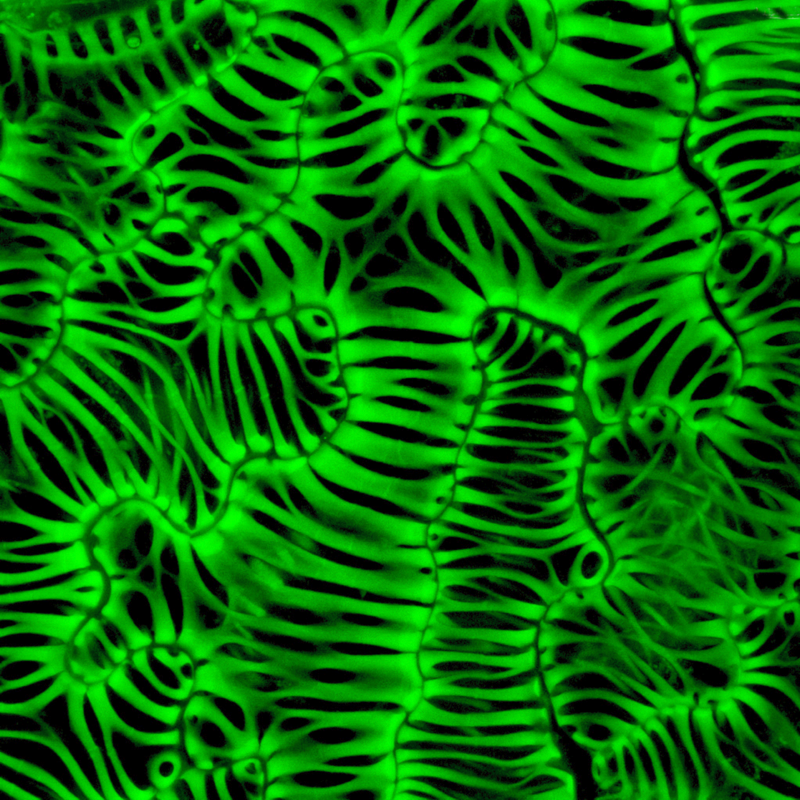
Columbia University SynBio architecture studio
We are working in collaboration with architect David Benjamin (Columbia University, NY, US) to incorporate synthetic biology into architecture studios by developing a new teaching platform for architecture master students of Columbia University. We have also collaborated in a Sci-Art project funded by NSF-EPSRC, in which we explored the use of biological systems as design and manufacturing tools. In contrast to digital fabrication and CNC machines, we experimented with the manipulation of living cells to render 3D exoskeleton solutions for different shapes and volumes. While there are many examples of identifying and applying the “form of nature” in design and architecture, there are few examples of using the logic underlying morphogenesis. We used xylem cells, which form seamless exoskeleton structures in the plant vascular tissue composed mainly of cellulose and lignin. Xylem patterns are rendered in response to each cell shape. The 3D ligno-cellulosic structure prevents cells from collapsing under the high negative pressure during water transport. Our project is based on the use of this genetic program that renders adapted patterns in response to different shapes (cell envelopes). We used transgenic Arabidopsis plants (35S::VND7/6-GR courtesy of Dr Demura, Japan), to induce xylem development in different cells with wide range of different shapes (e.g. leaf cells). Next, we executed the xylem program in isolated cells (protoplasts) constrained by custom-designed shapes in micro-fluidics devices. Finally, we used evolutionary computing to adapt xylem structures to different scales, loading conditions and material displacement
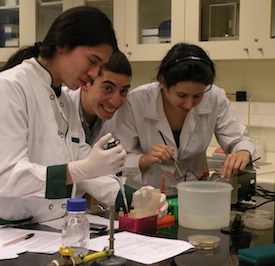
SynBio/iGEM Latino America
The international Genetically Engineered Machine competition (iGEM) is a contest in Synthetic Biology for undergraduate students that has provided a new educational model for teaching bioengineering. The competition is held in the spirit of robotics competitions in engineering fields, except that the students face the challenge of conceiving, designing and implementing a synthetic biological system using standard, interchangeable DNA parts or “BioBricks” and operating it in living cells. We have helped in the organization of SynBio workshops in Santiago, and Universidad Austral de Valdivia, Chile. These workshops are part of a long-term collaboration with Chilean academics Dr Rodrigo Gutierrez and Bernardo Pollak, who aim to integrate Chile into the international community of the new field of Synthetic Biology and its emergent economy. This effort has given rise to the creation of one of an iGEM team in Pontificia Universidad Católica de Chile (http://www.igemuc.cl), one of the first in South America; and series of collaboration with academics from Universidad Católica and Adolfo Ibanez to describe symbiotic mechanisms between plants and microbes.
Research Experience
1999: Agricultural Engineering. Universidad Nacional de Cuyo (UNC) Mendoza. Argentina.
2000 - 2004: Bachelor’s Degree in Biological Sciences Pontificia Universidad Católica de Chile. Santiago. Chile.
2005 - 2009: PhD in Biological Sciences. Thesis: Regulation of cell division in plant roots. Department of Plant Sciences, University of Cambridge.
2010 - present: Postdoctoral Research fellowship. “The programmable rhizosphere” project on Synthetic Biology in the Haseloff lab in collaboration with Prof. A. Wipat, Prof. C. Voigt, Prof. C. Smolke, and Prof. K. Bhalerao (NSF/EPSRC).
Other research experience:
1999: Institute of Animal Biology. Agronomic Sciences School. Universidad Nacional de Cuyo (UNC). Mendoza. Argentina. Head of Group: Dr Enrique Pereyra.
2002: Laboratory of Neurobiology. Pontificia Universidad Católica de Chile. Head of Group: Dr. J.C. Saez.
2002 - 2003: Laboratory of Biochemistry. Department of Molecular Genetics and Microbiology. Pontificia Universidad Católica de Chile. Head of Group: Dr. Patricio Arce-Johnson.
2004: Laboratory of molecular Genetics, Development and Evolution in plants. Universidad Nacional Autónoma de México, U.N.A.M. Head of Group: Dr. Elena Alvarez-Buylla.
1999: Agricultural Engineering. Universidad Nacional de Cuyo (UNC) Mendoza. Argentina.
2000 - 2004: Bachelor’s Degree in Biological Sciences Pontificia Universidad Católica de Chile. Santiago. Chile.
2005 - 2009: PhD in Biological Sciences. Thesis: Regulation of cell division in plant roots. Department of Plant Sciences, University of Cambridge.
2010 - present: Postdoctoral Research fellowship. “The programmable rhizosphere” project on Synthetic Biology in the Haseloff lab in collaboration with Prof. A. Wipat, Prof. C. Voigt, Prof. C. Smolke, and Prof. K. Bhalerao (NSF/EPSRC).
Other research experience:
1999: Institute of Animal Biology. Agronomic Sciences School. Universidad Nacional de Cuyo (UNC). Mendoza. Argentina. Head of Group: Dr Enrique Pereyra.
2002: Laboratory of Neurobiology. Pontificia Universidad Católica de Chile. Head of Group: Dr. J.C. Saez.
2002 - 2003: Laboratory of Biochemistry. Department of Molecular Genetics and Microbiology. Pontificia Universidad Católica de Chile. Head of Group: Dr. Patricio Arce-Johnson.
2004: Laboratory of molecular Genetics, Development and Evolution in plants. Universidad Nacional Autónoma de México, U.N.A.M. Head of Group: Dr. Elena Alvarez-Buylla.
Publications
Arce-Johnson P, Poupin M, Medina C, Cadavid A, Federici F. P. Method to produce sterile flowers and seedless fruits by genetic silencing. US Patent. 7994397B2 (2011, US).
Arce-Johnson P, Poupin M, Medina C, Cadavid A, Federici F. Seedless Grapes by MADS gene silencing. Patent N° 3361-2006 (2006, Chile).
*Poupin M., *Federici F., Medina C., Matus J., Timmermann T., Arce-Johnson P. Isolation of the three grape sub-lineages of B-class MADS-box TM6, PISTILLATA and APETALA3 genes, which are differentially expressed during flower and fruit development. 2007 Gene 404:10-24.
(*joint first author)
*Ubeda-Tomás S., *Federici F., Casimiro I., Beemster G., Bhalerao R., Swarup R, Doerner P., Haseloff J., Bennett M. Gibberellin signalling in the endodermis controls Arabidopsis root meristem size. 2009 Current Biology 19:1194-9.
(*joint first author)
Maizel A., Wangenheim D., Federici F., Haseloff J., and Stelzer E., High-resolution live imaging of plant growth in near physiological bright conditions using light sheet fluorescence microscopy. 2011. Plant Journal 68:377-85.
Aquea F., Federici F., Moscoso C., Vega A., Haseloff J. and Arce-Johnson. A molecular framework for the inhibition of Arabidopsis root growth in response to boron toxicity. 2011. Plant Cell and Environment 35:719-34.
*Federici F., *Dupuy L., Laplaze L., Heisler M., and Haseloff J. Integration of computational and genetic techniques for in planta cytometry. Nature Methods 9: 483-485.
(*joint first author)
Brown J., Federici F., Dalchau N., Phillips A., Ajioka J., and Haseloff J. Ratiometric approach for promoter characterization in microbes. (in preparation for submission).
*Rudge T., *Federici F., *Steiner P.J., and Haseloff J. Emergence of fractal-like boundaries in bacterial biofilms (in preparation for submission). (*joint first authors)
Arce-Johnson P, Poupin M, Medina C, Cadavid A, Federici F. P. Method to produce sterile flowers and seedless fruits by genetic silencing. US Patent. 7994397B2 (2011, US).
Arce-Johnson P, Poupin M, Medina C, Cadavid A, Federici F. Seedless Grapes by MADS gene silencing. Patent N° 3361-2006 (2006, Chile).
*Poupin M., *Federici F., Medina C., Matus J., Timmermann T., Arce-Johnson P. Isolation of the three grape sub-lineages of B-class MADS-box TM6, PISTILLATA and APETALA3 genes, which are differentially expressed during flower and fruit development. 2007 Gene 404:10-24.
(*joint first author)
*Ubeda-Tomás S., *Federici F., Casimiro I., Beemster G., Bhalerao R., Swarup R, Doerner P., Haseloff J., Bennett M. Gibberellin signalling in the endodermis controls Arabidopsis root meristem size. 2009 Current Biology 19:1194-9.
(*joint first author)
Maizel A., Wangenheim D., Federici F., Haseloff J., and Stelzer E., High-resolution live imaging of plant growth in near physiological bright conditions using light sheet fluorescence microscopy. 2011. Plant Journal 68:377-85.
Aquea F., Federici F., Moscoso C., Vega A., Haseloff J. and Arce-Johnson. A molecular framework for the inhibition of Arabidopsis root growth in response to boron toxicity. 2011. Plant Cell and Environment 35:719-34.
*Federici F., *Dupuy L., Laplaze L., Heisler M., and Haseloff J. Integration of computational and genetic techniques for in planta cytometry. Nature Methods 9: 483-485.
(*joint first author)
Brown J., Federici F., Dalchau N., Phillips A., Ajioka J., and Haseloff J. Ratiometric approach for promoter characterization in microbes. (in preparation for submission).
*Rudge T., *Federici F., *Steiner P.J., and Haseloff J. Emergence of fractal-like boundaries in bacterial biofilms (in preparation for submission). (*joint first authors)